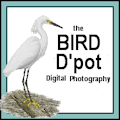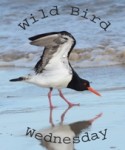Posted by: Ken @ 6:14 pm
A quick turnaround gave me this “butt shot” of a drab Palm Warbler, revealing bright yellow undertail coverts:
While I am thrilled to capture a “guide book” photo of a bird, whether a full side-on image, free of shadows and intervening twigs, or a flight shot that shows the details of all the feather groups, I have to admit that I find perverse enjoyment in photographing birds when they’re being just… well, birds.
A white heron visited our lawn and did not look quite right for an egret. It did not have the “golden slippers” characteristic of a Snowy Egret. Sure enough, its dark-tipped bill and uniformly dusky greenish legs gave away its identity– but it failed to “sit” for what would have been my first decent shot of an immature Little Blue Heron:
Sparrows and other “little brown jobs are particularly challenging. While birding with a Kane (Illinois) County Audubon group at Nelson Lake, we struggled to see a Sedge Wren as it crept through the brush. Intervening twigs made clear focusing impossible. Giving up on the wren, I lingered behind as the group proceeded on, trying to photograph a nearby Swamp Sparrow.
Suddenly, the Sedge Wren appeared only about 5 feet away, filling the frame. So many times, I had tried for good shots of this species, and this was an unbelievable opportunity:
Part of the fun of birding in the field is clinching the identification of a species that comes into view for a few nanoseconds as it peers out from deep vegetation, or before it disappears into the blue. Often, I do not know whether to reach for the binoculars for a better view, or the camera, for more leisurely study in front of the computer screen. Some of my favorite photographs recall just such moments. None of them could be considered “quality” shots, or “sale-able images,” as one professional photographer friend likes to call them.
It’s easy to find Painted Buntings all winter in South Florida at established feeders, but one sighting in the wild last year was much more enjoyable. As I was seeking warblers in some shrubs that border a small grassy patch in the wetlands near our home, I saw a flash of blue and red out of the corner of my eye. A male Painted Bunting then dropped down near the ground, never to be seen again. It permitted only one quick shot, but I like this one better than those at the feeder tray.
So far, this is the first male that I have seen in the birding patch adjacent to our subdivision:
Occasionally, I will find female Painted Buntings, also beautiful, dressed all in green:
I almost walked right past this heron before I noted its form disturbing the mottled pattern of leaves against the sky. My best shot confirms that it is a Black-crowned Night-Heron, distinguished from the Yellow-crowned species by its dark cap and sharply pointed bill:
Another similar heron appeared briefly atop a small tree just before flying off, providing me with one photo to be studied at home. Its thicker bill, slim body and the smaller wing spots identified it as a Yellow-crowned Night-Heron:
Last month, I heard an unfamiliar bird call, coming from some shrubbery along the ditch that leads westward from the levee trail. Then, the leaves started stirring. I aimed the camera, hoping to catch whatever might appear. It was a Gray Catbird, partially hidden. Then a bird with some very bright yellow plumage appeared in my viewfinder next to the catbird. I snapped the shutter, having no idea of its identity. Within a second it was gone, never to be seen again.
Only after I reviewed the image on my camera’s LCD screen could I see it was a Yellow-breasted Chat, my first local sighting of the species:
The first Savannah Sparrow I photographed in Florida was likewise uncooperative, preferring the safety of a clump of grass. I love its inquisitive look:
Similarly, a Swamp Sparrow refused to come out into the open. My clearest photo shows it ignoring me to forage peacefully in its secluded perch:
In Illinois, I stalked another reclusive sparrow, the Henslow’s. When it finally emerged from its hiding place, it “spoiled” my photo by immediately darting off:
An Eastern Meadowlark “saluted” me during its portrait session:
Why don’t birds just sit still? Ask this free-falling Orange-crowned Warbler…
…or this Golden-crowned Kinglet…
…who doesn’t need a trampoline…
…or a Spiderman harness:
I’m not sure whether this Downy Woodpecker’s jump was assisted by a quick wing beat before the
shutter clicked, but it looked like an Olympian on uneven parallel bars! Should I blame this shot on shutter lag or just my slow reflexes?
Seeking perfection can be hazardous. After I scared this Anhinga up from its favorite fishing hole, it turned around and flew directly over my head for what I thought would be a perfect photo opportunity. Luckily, I saw the threat through the viewfinder and quickly moved to my right as it dive-bombed me.
The “guided missile” would have painted my left shoulder and maybe my hat!

But then, on a magical day at Shark Valley in Everglades National Park, the planets were all in proper alignment:





























January 31st, 2011 at 12:05 am Great shot ! Feel for the fish but a birds got to eat.